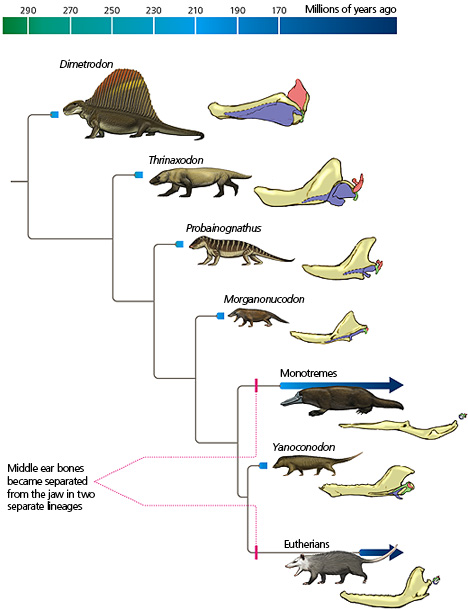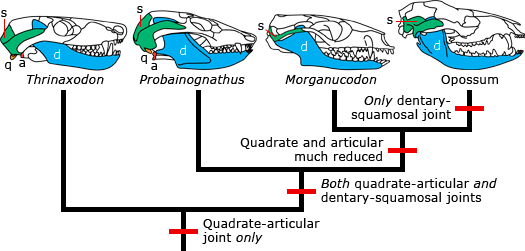All the animals you see on this evogram are synapsids, the group that gave rise to the mammals. Sometimes synapsids are called “mammal-like reptiles;” however, that is misleading because synapsids are not reptiles. Synapsids and reptiles are two distinct groups of amniotes, animals that produce young that are enveloped with a membrane called an amnion that prevents desiccation. All reptiles (including birds) have eggs with amniotic membranes (which some lay and others retain inside their bodies until hatching). And of course all mammals (the clade of synapsids still alive today) reproduce using an amnion, and those that lay eggs (e.g., the platypus and echidna) produce amniotic eggs.

Like birds, crocodiles, turtles, snakes, lizards, amphibians, and most fishes, the earliest synapsids had a bone in the back of the skull on either side called the quadrate that made the connection with the lower jaw via a bone called the articular. But mammals today, including humans, use two different bones, called the squamosal and the dentary, to make this connection. How did this new jawbone configuration evolve?
For reasons we don’t fully understand, several lineages of synapsids — including the one that would eventually give rise to the mammals — began to evolve changes in the jaw joint. Originally the quadrate and articular bones formed the jaw joint, but these synapsids (e.g., Probainognathus) evolved a second pair of bones involved in the jaw articulation. The squamosal bone was positioned alongside the quadrate in the upper jaw, and the dentary was positioned alongside the articular in the lower jaw.

This unusual paired condition did not last long, though. Soon, the quadrate and articular lost their function in jaw articulation and even their position in the jaw as they evolved. They became increasingly smaller and eventually migrated into the ear region, where they became the “hammer” and “anvil” of the ear. So, over time, the synapsids’ quadrate-articular jaw joint (which the rest of the tetrapods possess) was replaced by a dentary-squamosal joint (which all living mammals possess), while the quadrate and articular migrated, shrank, and became part of the complex of middle ear bones.

Only in recent years has it become apparent that several lineages of synapsids, including mammals, replaced their quadrate-articular jaw joint with a dentary-squamosal joint. We don’t fully understand why these changes happened. Some evidence suggests that the change in the quadrate-articular complex improved hearing. Other evidence suggests that these changes were a byproduct of early mammals’ increasing brain size. These ideas are not mutually exclusive, of course, and more research is needed. Whatever the functional advantages may have been, the pattern of evolution in these features clearly shows another example of exaptation: the incorporation of the dentary and squamosal bones into the jaw joint, originally alongside the quadrate and articular, eventually allowed the latter two bones to acquire a completely different function and to leave the jaw articulation altogether.
